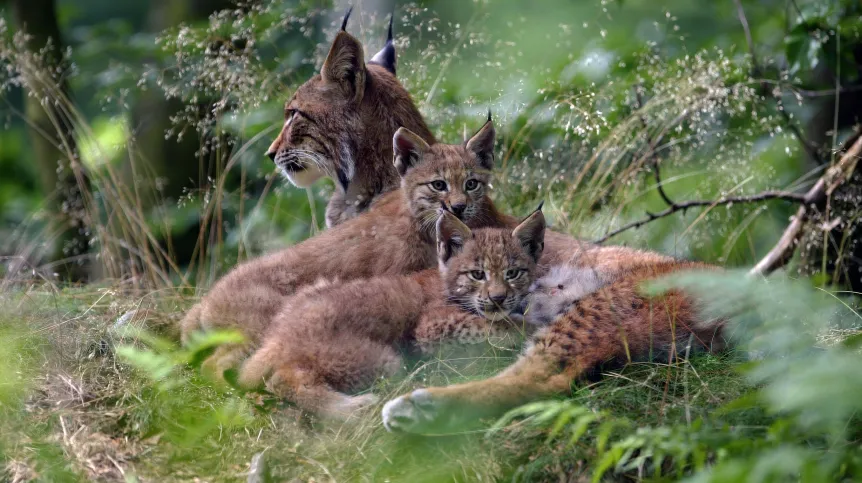
Releasing lynx saved from death into the natural environment is a good solution, it supports local populations of these predators, say experts after analysing the fate of 66 lynxes released after rehabilitation. The condition is professional rehabilitation of these wild animals.
After centuries of extermination, Eurasian lynx has been covered with protection in many European countries. In Poland, where these predators previously were a game species, lynx were placed under strict protection in 1995 in response to the demands of nature organizations and scientists. However, lynx protection on a continent as densely populated and fragmented by roads and buildings as Europe is a huge challenge, Polish researchers, participants of international research project that analysed the fate of orphaned young lynx, write in the release sent to PAP - Science in Poland.
Researchers are therefore looking for new ways to restore wild felid populations. Recent analyses show that an auxiliary method is the rehabilitation and release of orphaned lynx into the natural environment.
A team of 40 researchers from 18 countries analysed the fate of 320 orphaned lynx kittens found in Europe between 1975 and 2022, including ten in Poland. On this basis, the researchers prepared recommendations on how to proceed in this type of cases. The research results have just been published in the journal PLOS ONE.
Kittens remain with mother for about a year, the authors of the analyses remind. During this time, the female first feeds them with milk and then takes them to the prey she hunts, usually wild ungulates, e.g. deer.
Orphaned kittens, deprived of food supply, often approach human habitations, where they feed on food for pets or attempt to hunt livestock. Some lynx kittens were found in even more dramatic circumstances, for example, one was saved from drowning, another strayed into a railway tunnel. Most of them were found in October and November, when the young are 6-7 months old, but there were also individuals that were only a few days old. Most of the orphaned kittens were exhausted and malnourished, some were injured.
The biggest surprise for researchers was the extremely different approach to orphaned lynx in different European countries. Attempts to save them were not made everywhere. Young lynx in Switzerland were in the worst situation: 39 kittens were left in the forest without help and as many as 37 were killed due to the lack of rehabilitation centres or the lack of political will to help them. In other countries, attempts were made to save most orphaned kittens. However, 66 percent of them died due to their poor health. Those that were cured and rehabilitated were released back into the wild or placed in zoos.
Scientists used various methods to monitor 66 lynxes released after rehabilitation. Two-thirds of them survived for at least a year, and ten animals reproduced at least once. One of the most important factors increasing the success of released lynx in returning to nature was their body weight - the heavier the lynx, the greater its chances of survival.
'This study has clearly shown that it is worth trying to save orphaned lynx kittens, says the publication co-author, Dr. Robert Mysłajek, a professor at the University of Warsaw and vice-president of the Association for Nature WOLF. 'However, for such activities to have a chance of success, professional wildlife rehabilitation centres are needed with conditions for rescuing and treating large predators and constant cooperation with people who study this species'.
In Poland, successful actions to save orphaned lynx were carried out by the Association for Nature WOLF in cooperation with the Mysikrólik Foundation, which runs a wildlife rehabilitation centre in Bielsko-Biała. Thanks to their activities, three orphaned lynx kittens, two from the Carpathians and one from Roztocze, returned to nature.
'Thanks to telemetry collars that we equipped the lynx with before releasing them, we could monitor them and knew how they were doing in the wild. It turned out that the lynx acquired food without any problems and found safe shelters in the forest, away from human settlements', says the study co-author, Dr. Sabina Nowak, a professor at the University of Warsaw and president of the Association for Nature WOLF.
Returning rehabilitated lynx to the natural environment is a better method than catching wild lynx and resettling them to new areas, because it does not deplete the source populations, the scientists emphasise in the release sent to PAP - Science in Poland.
In-depth research on the possibility of using individuals rescued from accidents or orphaned and then rehabilitated to protect the population of large predators is currently being carried out as part of a joint project of the Faculty of Biology of the University of Warsaw and the Association for Nature WOLF, co-financed by the Ministry of Science and Higher Education under the 'Implementation Doctorate' programme. (PAP)
PAP - Science in Poland
zan/ agt/ kap/
tr. RL













